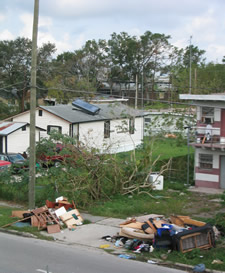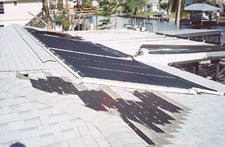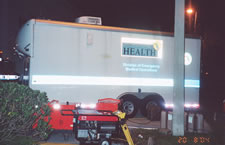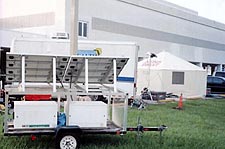
|
|
October 2004 |
Hurricanes
Keep Bill Young Busy with Solar-Power Disaster When Florida’s highways started jamming up with people evacuating their homes as hurricanes Charley and Frances roared toward the state, Florida Solar Energy Center's (FSEC) Bill Young was driving in the other direction.
It had been 12 years since he first took some FSEC PV training equipment down to Homestead to help in the recovery efforts after Hurricane Andrew, and the monstrous storms approaching the state signaled that it was time for him to go into action again.
Young, a Senior Research Engineer in FSEC’s Photovoltaics(PV) and Distributed Generation Division, has been working on “Disaster Resistant Buildings” for the past few years with groups like the non-profit Institute of Business Home Safety in Tampa, conducting training programs on the use of photovoltaics and solar energy in disaster response, recovery and mitigation. Several of the groups he works with are involved in designing and building homes and businesses that can withstand the forces of a disaster like a major hurricane. Bill adds the energy component. “Solar systems can make these buildings functional,” he says. “Strong building codes are helping ensure that buildings remain standing after getting hit by hurricane-force winds. The solar systems ensure that the residents can get back into their homes and not have to wait days or even weeks for power.” On August 16, just days after the hurricane blasted Florida’s west coast, Young joined disaster damage assessment teams in the Punta Gorda and Port Charlotte areas who were evaluating wind damage to roof materials and inspecting design performance of buildings. He spent six days climbing on roofs and trudging through buildings to see how well they held up during the storm. “The team I was with looked at homes with shingle roofs, and we found that about half of the solar systems that had been in place were still there and working,” he noted. “It was clear that the stronger building codes in recent years made a big difference in keeping so many buildings in good shape.”
He brought along his solar power trailer that was built for the frequent disaster-relief training programs he conducts. The trailer contains 600 watts of PV power, a 2000-watt inverter and 1500 watts of battery storage. “I drove around looking for a disaster medical assistance team working with FEMA, and found one in a tent outside of Fawcett Memorial Hospital. Actually, I heard the sound of their petroleum-fueled generator before I even saw them. I’ve learned from medical teams at other disasters that there’s a real psychological trauma at disasters caused by the noise and smell of diesel generators, and the doctors were very glad to see my quiet PV equipment. We set it up at their medical tent and it worked beautifully. The trailer gave them the power they needed for their tent and allowed them to treat injuries to relieve the burden on the hospital staff and facilities.” He also worked with other disaster relief teams looking at the use of other roof-mounted solar equipment like solar water heaters and pool heaters and how they could continue to operate efficiently while power was otherwise unavailable.
A brief trip back to FSEC gave him the chance to replenish his supplies and then spend a few days in Colorado giving a paper on the use of photovoltaics in disaster and energy security applications (click here for a copy of the paper) and conduct a workshop on solar energy use in disasters at the World Renewable Energy Congress. He got home just after Hurricane Frances hit the Central Florida area and again joined in disaster relief efforts. Bill worked with the local Emergency Operations Center in Rockledge and helped with ham radio operations and communications. Young has become a national figure in the solar energy field in the area of disaster relief since his work after the devastating Hurricane Andrew in South Florida 12 years ago. Back then, he had been working with the Florida Department of Transportation on a contract to use solar energy in their operations to power call boxes, message signs, traffic signals and other equipment. “I think there were about 1800 traffic signals down after that hurricane hit,” he explained, “and since I had been working on using PV to power signals, I went right down to the area and spent two weeks there with the two FSEC training kits we had used in our classes. They had the typical components needed for a stand-alone system – PV panels, inverters, lights and hardware – and they helped get a lot of traffic lights operating again. A week later, Jim Dunlop and some other FSEC staff members came down also and brought a lot of PV equipment that they took off of our building and even test stands. We used it to supply power to four medical clinics that were being set up in the area." Since his volunteer efforts after Hurricane Andrew, Young has been giving more than a dozen workshops and presentations every year on the use of solar energy in disaster relief efforts. You can find out more about his activities at http://www.fsec.ucf.edu/en/consumer/disaster/index.htm. “I think the bottom line of this work,” he notes, “is that people must be prepared for disasters and not just wait until they happen to figure out what to do. It’s one thing for the government to spend millions of dollars after a hurricane or other disaster to help fix everything up and get life back to normal, but it’s a whole lot more desirable to plan for problems and use systems like photovoltaics to make sure that you have power when the utility isn’t able to provide it. I saw this in my own neighborhood after Hurricane Frances when I drove around the area and noticed many people sitting on lawn chairs in their driveways. Their homes were still standing and looked to be in pretty good shape, but they still had not gotten their power back. Photovoltaics could have been providing power, and solar thermal systems could have let them shower and enjoy indoor hot water.” Bill Young's paper on photovoltaics in
disaster and energy security applications: |




